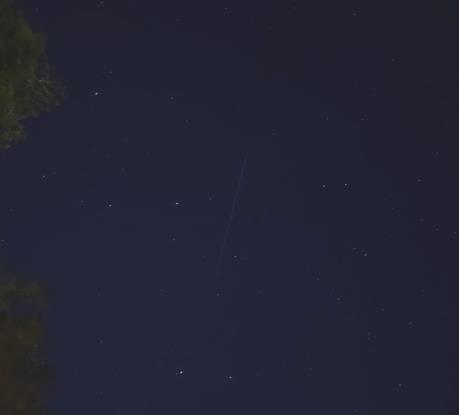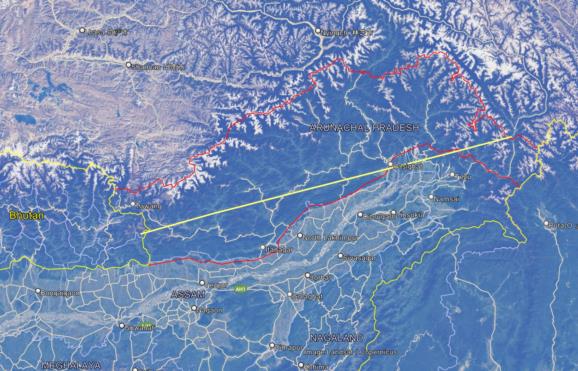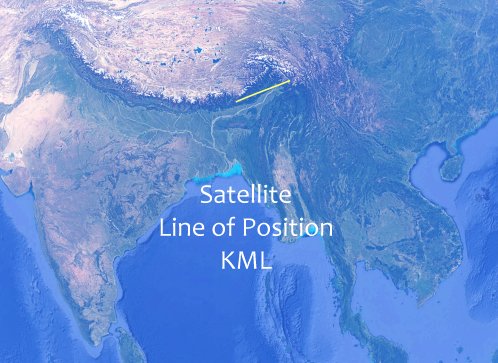
NavList:
A Community Devoted to the Preservation and Practice of Celestial Navigation and Other Methods of Traditional Wayfinding
From: Frank Reed
Date: 2023 May 25, 09:11 -0700
Here's a nice example of position determination by visual observation of artificial satellites.
An observer in the northeast corner of the state of Assam in India had posted some photos in a Facebook "Visual Satellite Observation" group a couple of weeks ago. They were of prominent satellites, like the Hubble Space Telescope, trailed in exposures of thirty seconds or so. He took the images with a relatively common smartphone. I thought it would be fun to try to get his observing location from these photos, but the photos were from 3-9 months ago, and analyzing satellite positions requires relatively synchronized orbital elements. While it's possible to get old elements, I didn't want to invest that much work. I asked him to post a recent photo when he had a chance.
Yesterday, my Indian informant, Abhijit Paul, posted a photo of a satellite pass. He indicated that he had taken the photo on May 23, and critically, he had identified the satellite as "Atlas Centaur 2 R/B (694)". This is an old one! It's a defunct rocket second stage, and apparently this was the very first hydrogen-fuelled rocket of any type to reach orbit. That was sixty years ago on November 27, 1963. For some historical pop-culture perspective, that was five days after the very first episode of Doctor Who was launched on television. It was also a week of tragedy and political drama, of course. The day it was launched, the launch site was Cape Canaveral. The next day, Thanksgiving Day in the US, President Johnson announced in a televised address to the nation that it was from that day forward renamed as Cape Kennedy... That didn't last.
It is somewhat unusual to find satellites so old still in orbit, and this one has survived because it is relatively high, on average over 800km in altitude. As a satellite flies overhead its position can be observed against the background of the stars. The satellite's observed position depends on the observer's ground location. In celestial navigation terms, its parallax shifts its poisition, much as the Moon's position is shifted by parallax. And just as an exact measurement of the Moon's position (exact lunar distance angles. e.g.) can determine an observer's approximate latitude and longitude, so also by observing a low-orbit satellite we can get a fix of an observer's position on the ground. If we don't know the exact UT, we get a line or arc of position, usually close enough to straight to earn the title "line", so let's call it a "satellite LOP".
Picture a satellite at 800km altitude flying directly overhead. If I observe it passing directly over the star Arcturus, for example, visually coincident with Arcturus for a moment, then using proper satellite ephemeris software, I should be able to find locations on the ground where that observation was possible. Suppose I move 1km perpendicular to the direction of the satellite's motion. The satellite then would no longer pass exactly over Arcturus. The track of the satellite relative to the background stars will shift by an angular ratio of 1km/800km or 0.00125. As usual for a small angle, I can convert that to minutes of arc by multiplying by 3438. That gives 4.3'. This is easily observed visually, especially with binoculars, and easily observed in good photos, too.
I have permission from Abhijit Paul to share his photo. It's attached below. Given that he lives in Assam, India and given the date and the identification of the satellite, you can determine a line of position on the ground. This process can go in two directions at square one. We need to decide what stars we're looking at. This can be done in automation. Given a sufficient star database, astrometric software can relatively easily match up the stars in the image and tell us what we're looking at. Alternatively, as a skilled star navigator with years of experience looking at the constellations, you can identify what you see without software. I'm in the latter category (not by navigation per se, so much as ordinary stargazing), and, as it turns out, I have unusual skill identifying portions of star patterns in photos like this. It took me all of five seconds to identify this star field. There's a first magnitude star just out-of-frame to the lower left. The large triangle toward the upper left is significant.
You know the satellite. You know the "D.R." position within a few hundred miles. You know the date is 23 May 2023. So where are you? Without an exact UT or a second satellite track photo, we can only determine a locus of possible positions --a "satellite LOP". But this LOP is every bit as good as a common celestial LOP, and it requires no sextant to measure angles.
I'm attaching my solution as an LOP in an image and a KML file that you can load in Google Earth. I solved this simply by generating predictions at heavens-above.com for integral values of longitude in the region. That site uses standard high-quality satellite ephemeris software and produces moderately high-resolution star charts which can be matched to photos.
Frank Reed
Clockwork Mapping / ReedNavigation.com
Conanicut Island USA









